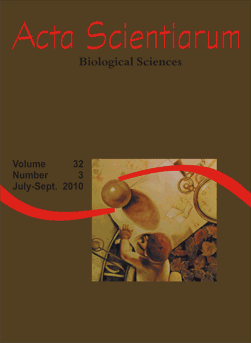<b>Ecotoxicity of glyphosate and aterbane<sup>®</sup> br surfactant on guaru (<em>Phalloceros caudimaculatus</em>)</b> - doi: 10.4025/actascibiolsci.v32i3.6795
Keywords:
tropical fish, toxicity, herbicide
Abstract
Aquatic macrophytes are important components of aquatic ecosystems, but these plants have become a problem due to their occurrence in different regions. Some studies aimed to demonstrate the effectiveness of herbicides to control these macrophytes; however, few studies report the possible ecotoxicological effects. The objective of this study was to estimate the acute toxicity (LC (I)50;96h) and assess water quality variables for glyphosate in the Rodeo® formulation, Aterbane® BR surfactant and mixtures of glyphosate + 0.5% and 1.0% of surfactant, for the guaru fish (Phallocerus caudimaculatus). The guaru was exposed to increasing concentrations of glyphosate and a mixture of glyphosate + 0.5 and 1.0% of surfactant. The mixture of glyphosate and glyphosate + 0.5 and 1.0% of surfactant showed (LC (I)50;96h) > 975.0 mg L-1. For the surfactant, the rate was 5.81 mg L-1. The glyphosate and mixtures of glyphosate + 0.5% and 1.0% of surfactant caused a decrease in pH and dissolved oxygen and increased the electrical conductivity of water. Glyphosate in the Rodeo® formulation and the mixtures with surfactant Aterbane® BR can be classified as practically nontoxic, whereas surfactant Aterbane® BR can be considered as moderately toxic to guaru.Downloads
Download data is not yet available.
Published
2010-09-14
How to Cite
Shiogiri, N. S., Carraschi, S. P., Cubo, P., Schiavetti, B. L., Cruz, C. da, & Pitelli, R. A. (2010). <b>Ecotoxicity of glyphosate and aterbane<sup>®</sup> br surfactant on guaru (<em>Phalloceros caudimaculatus</em>)</b> - doi: 10.4025/actascibiolsci.v32i3.6795. Acta Scientiarum. Biological Sciences, 32(3), 285-289. https://doi.org/10.4025/actascibiolsci.v32i3.6795
Issue
Section
Ecology and Limnology
DECLARATION OF ORIGINALITY AND COPYRIGHTS
I Declare that current article is original and has not been submitted for publication, in part or in whole, to any other national or international journal.
The copyrights belong exclusively to the authors. Published content is licensed under Creative Commons Attribution 4.0 (CC BY 4.0) guidelines, which allows sharing (copy and distribution of the material in any medium or format) and adaptation (remix, transform, and build upon the material) for any purpose, even commercially, under the terms of attribution.
Read this link for further information on how to use CC BY 4.0 properly.
0.6
2019CiteScore
31st percentile
Powered by 

0.6
2019CiteScore
31st percentile
Powered by 











1.png)




3.png)













